Ouch! Dangerous Plants and Animals at the Beach
BY T. Travis Brown
| We’ve all heard about venomous animals and poisonous plants from far-off places but what about our own backyards? Here are a few of your not-so-cuddly neighbors. | |
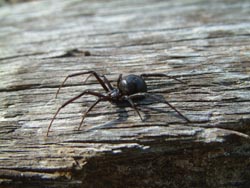 | Black Widow Few spiders can match the reputation of the black widow. This midnight-black spider is infamous for biting humans and for the females frightening habit of killing her mate. A bite from this species may not result in much swelling or tissue necrosis (black dead tissue) but it is extremely painful. This is because unlike many hemotoxic venoms that destroy flesh surrounding a bite black widow spider venom contains neurotoxins meaning that the venom attacks the nervous system. A bite from this spider is extremely painful but rarely fatal to a healthy adult. |
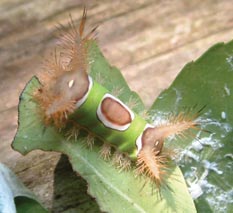 | Saddleback Caterpillar Saddleback caterpillars are brightly colored and can be quite intriguing to children and bug-loving adults alike. Even if you are not prone to handling every colorful bug that you see you may come into contact with a saddleback that is hanging out on the bottom of a leaf. This caterpillar can give you quite a surprise if you brush up against it. The tufts of hairs that cover portions of its body are filled with a fairly powerful irritant that causes stinging welts that may persist for quite some time. Dont worry too much the pain will pass and the caterpillars will eventually turn into moths. |
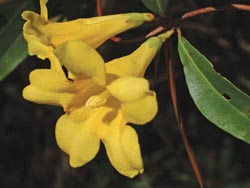 | Yellow Jessamine During spring and early summer this yellow flowering vine also called jasmine covers most of the southeastern U.S. coastal plain. Unfortunately for such a beautiful flower this species has a couple of negative qualities. First of all it contains several toxic alkaloids that are concentrated in the flower nectar. In fact children have been poisoned by this flower after mistaking it for Japanese honeysuckle a vine with sweet-smelling white flowers from which children (and adults) often suck nectar. Also like Japanese honeysuckle yellow Jessamine is an invasive plant that smothers and strangles native plants even 70-foot-tall trees! |
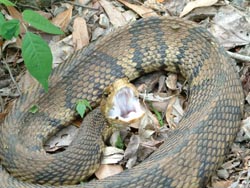 | Cottonmouth Cottonmouths also known as “water moccasins ” are largely a creature of wooded swamps. However most people dont realize that they also inhabit the marshes of our sounds and tidal streams. Although rarely lethal to a healthy adult the hemotoxic venom of a cottonmouth bite causes extreme pain and may lead to the amputation of a finger. On the bright side you dont have too much to fear from this snake unless you are trying to pick it up (definitely ill-advised) trying to kill it (try running away instead please) or some combination of the two. |
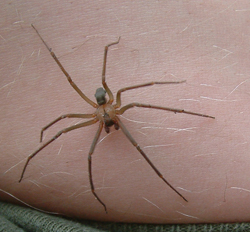 | Brown Recluse True to its name this spider hides under boards behind furniture and in other dark recesses. Recluses are generally docile spiders that would rather run and hide than bite. Because of their nature they are easily overlooked putting on clothing that has been lying on the floor or picking up a board without looking at the underside for instance. But be warned: brown recluse bites often produce disastrous results. Many people do not even realize that theyve been bitten at first but eventually the hemotoxic venom leads to damaged tissue which may have to be removed leaving a gaping wound. (Absolutly dont try this at home. The person in the photo is a professional naturalist … and maybe just the slightest bit nuts.) |
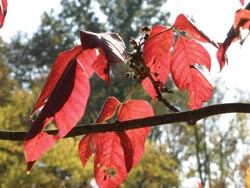 | Poison Ivy Everyone has heard of poison ivy but very few can actually identify it. Heres why: Its a shape-shifter taking the form of an erect plant a ground cover or a robust vine that looks like the branches on a tree. The big clue is that it has three leaflets per leaf white/yellow/green berries and hairy vines. In the fall the leaves can turn from green to brilliant shades of orange and red. Only about 50 percent of humans are allergic to the oils found in all parts of the poison ivy plant but one can become suddenly sensitive after a lifetime of being rash-free. Irritation can come from direct contact with the plant but exposure can also happen after petting a poison ivy-covered pet or even by breathing the smoke from burning poison ivy. |
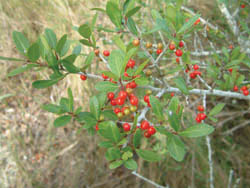 | Yaupon Holly This shrub grows wild along our coast but is also used in landscaping. In the wild it can be found on the fringes of marshes or on dry hummocks. Incidentally its Latin name Ilex vomitoria sounds a lot like what youll be doing if you eat too many yaupon berries which cause vomiting and diarrhea if eaten in large quantities. The bright shiny red berries make this a wonderful landscaping plant but they are also especially enticing to small children who are more sensitive to poisoning than adults. Native Americans used the leaves to make a caffeinated ceremonial beverage but too much of it also causes vomiting. |
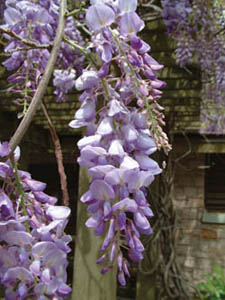 |
Wisteria is a flowering woody vine that can be found growing wild or in landscaping all over the eastern United States. Its a tough vine and trains readily onto trellises to make shady overhangs covered with flowers in the spring and summer. This plant is tempting to taste for several reasons. Its in the pea family and the lavender flowers look like some edible pea flowers that are sometimes used as a garnish. Also the flowers eventually turn into seed pods that may look similar to a pea pod. However all parts of the plant should be considered toxic as they contain a poison named wistarine. |
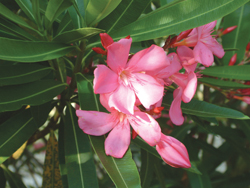 | Oleander When springs azalea blooms give way to summer Oleander takes up the torch. Oleander is a beautiful flowering shrub that has woven its way into the fabric of our community. However it can also be very dangerous. The leaves in sufficient quantity are toxic to both humans and livestock. Like yellow Jessamine this flower has poisoned children who sucked its nectar. Even smoke from the leaves can cause poisoning including dizziness vomiting and heart dysfunction caused by the aptly named chemical oleandrin. |
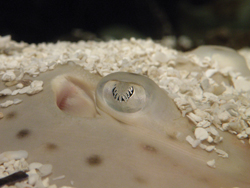 | Stingray Several species of stingrays can be found along the waters of Wrightsville Beach. Stingrays and skates (stingrays relatively harmless cousins) both belong to a group of fishes called batoids. Unlike skates stingrays give birth to live young and have venomous spines located on their tails. Most injuries from these flat fishes occur when an unseen stingray is stepped on. If you are injected with a stingray spine it is best to wash off any venom that is remaining and submerse the area in hot water (113 degrees Fahrenheit) until the pain subsides. The spine is covered in barbs that make it difficult to remove without causing more damage so it may be best to let a doctor do this. If the injected spine is near a major blood vessel or vital organ a doctor is definitely in order. |
Okay so youre never going outside again. Relax! The worst offender the brown recluse lives its entire life within a few feet of thousands of people but the great majority of us have never been bitten by one. Learning about our “dangerous” friends empowers us to avoid injury illness or worse. Keep your eyes open especially where your children are concerned (and be aware of boards on the ground and wild berries in the yard). If it doesnt come from a market garden or store that you trust you probably shouldnt be eating it.
If you would like to learn more about dangerous critters and plants check out the Peterson Field Guides: Venomous Animals & Poisonous Plants (Steven Foster/Roger Caras Houghton Mifflin Harcourt 1998).